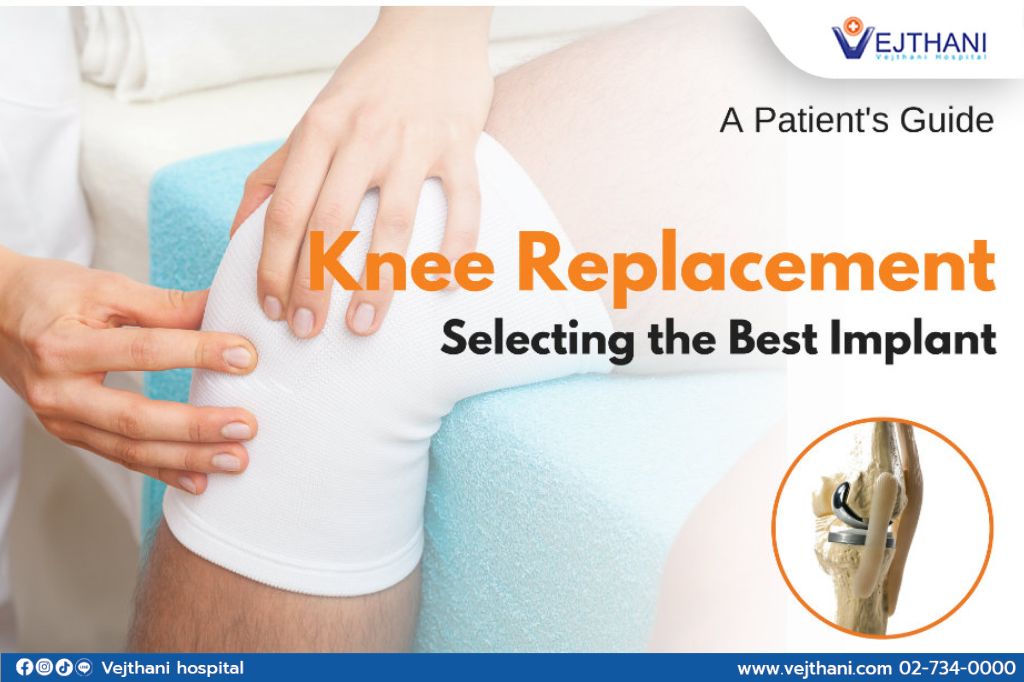Knee Replacement Surgery with Native Alignment Technique
Discover how robotic-assisted knee replacement with natural alignment restores movement, reduces pain, and provides a more natural feel at Vejthani International Hospital.

Prosthetic implants composed of three parts that are made from metal alloys and durable polyethylene are used by orthopedic surgeons in knee replacement surgery to resurface the damaged knee with artificial components. In a total knee replacement surgery in Thailand, implants are used to replace the surface of the lower end of the femur, the top surface of the tibia and the back surface of the patella. For smooth motion and durability, the metals used in implant components are designed to be used in conjunction with special durable polyethylene.
As several manufacturers in the orthopedics field produce and advertise implants, there are currently over 150 designs available, so choosing the best knee replacement is almost like buying a home. It requires in-depth research. It is natural to seek advice from others when making such decisions. However, their differing opinions may add to your dilemma.
The same holds true when choosing the best implant for total knee replacement in Thailand – specialists may have differing opinions. This is why a comprehensive evaluation of several criteria beforehand is recommended. After all, the features of prosthetic implants play a pivotal role in the success of total knee replacement surgery in Thailand or anywhere else in the world.
The surgeons generally base their selection of implants on the patient’s knee problem and anatomy; the patient’s age, weight, level of physical activity and general health; their own experience and acquaintance with the device; and finally, the price of the knee replacement components.
The traits of an ideal knee replacement implant are as follows:
Total knee replacement surgery in Bangkok can offer most implants or prostheses. If you need more information about a particular implant, it is best to consult your surgeon.
The knee is generally regarded as a hinge, it functions like a hinged door and is complex since its bone surfaces have to roll and glide for normal motion. Most implants are designed with knee joint complexity in mind, generally trying to preserve the ligaments that support healthy knees. Some implants substitute ligaments to precisely facilitate normal knee motion. In addition to these mechanics, it is important to consider the longevity, durability and price of a total knee replacement in Bangkok.
Some of the most popular implant designs are discussed below.
Posterior-stabilized designs are the most commonly used. In this design, the anterior cruciate ligament (ACL) and the posterior cruciate ligament (PCL) are completely removed, and implant components replace the PCL. However, the polyethylene part experiences more stress in posterior-stabilized designs resulting in faster wear down.
The Posterior Cruciate Ligament (PCL) is retained in this implant design which is designed with grooves to accommodate PCL, and the Anterior Cruciate Ligament is removed as the ACL may degenerate by itself in severe osteoarthritis cases.
This design is ideal for patients with a healthy posterior cruciate ligament that can stabilize the knee implant and participate in the roll sack mechanism of the knee after Total Knee Arthroplasty and control the joint line during the operation. Furthermore, it can reduce the bone cut, thereby preserving some for future revision TKA. Total knee replacement surgery at Vejthani Hospital in Thailand is a favorite destination for this procedure.
Both the anterior and posterior cruciate ligaments are retained in this design to make implants function as closely as possible to normal knee joints. As bicruciate-retaining implant components are somewhat new to the market, their pros and cons are still under evaluation.
Unicompartmental implants, which are smaller than standard implants, can resurface a particular side of the knee joint when it is only partially damaged. Partial knee replacement can be more beneficial than total knee replacement if the knee damage is not severe and limited to just one side. Find out more about partial or total knee replacement in Thailand from your surgeon.
Most of the implants used in total knee replacement have a fixed-bearing design in which the tibial component is firmly attached to the metal component that lies beneath it. The femoral component, which mimics the lower end of the thigh bone, rolls on this cushioned surface.
However, fixed-bearing implants can wear down quickly if the patient has high activity levels or gains extra weight. A worn-out implant that loosens from the bone’s surface can cause pain and implant failure. However, fixed-bearing implants may be cheaper for some patients, so doctors will consider the price of a knee replacement in Bangkok.
Mobile-bearing designs need substantial support from ligaments and other soft tissues because the tibial component can only rotate short distances within the metal tibial tray. This artificial joint may dislocate and fail if the soft tissues cannot balance the ligament tension during the operation.
Mobile-bearing implants are usually more expensive than fixed-bearing implants and give the feeling of optimum mobility, similar to that of the natural knee after the operation. This design allows a few more medial and lateral rotation degrees and is especially recommended for younger, highly active, or obese patients. When possible, surgeons recommend this implant to total knee replacement patients in Bangkok.
Generally, implants are placed with polymethylmethacrylate, a fast-curing bone cement. However, implants can fit onto bone without cement as well. Cementless fixation uses implants with a material that promotes the growth of new bone into the implant surface. Another approach is hybrid implant fixation, in which the femoral component is press-fitted without cement while the tibial and patellar components are held in place with cement.
Surgeons select an appropriate implant by thoroughly evaluating the brand, design, and fixation method according to the patient’s situation. Patients are advised to talk to their doctor about their decisions and the reasons behind them.
Hip and Knee Center, Vejthani Hospital
Call: (+66)2-734-0000 Ext. 2222
English Hotline: (+66)85-223-8888